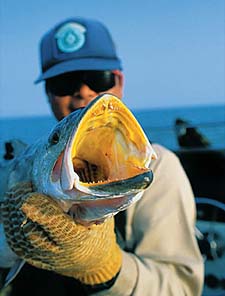|
Beating Baffin's Home Team
to Trophy Trout
By Buddy Gough
page 2
 The Front of Baffin Bay: The Front of Baffin Bay:
This is the area of the famed rocks where the names are legendary
in the annals of trout fishing-Point of Rocks, The Badlands and
Pensacal Point.
Here at the mouth of Baffin, the anglers find the shallow rocks
near the deepest water of Baffin Bay next to even deeper waters
of the Intracoastal Waterway and the Riviera Channel. It's this
shallow rocks/deep water connection that makes the front of Baffin
the most productive trout terrain in the lagoon for a high percentage
of success.
Forget it, says David Green, one of the top trophy trout catchers
in Baffin Bay. He and his clients pulled in 66 trout of 30 inches
or better during 1996, but saw the trophy numbers drop to 14 during
the off-year of 1997. He's hoping for improvement in 1998, but
he doesn't expect early action to be best on the rocks where the
weekend fishermen tend to congregate.
Rather, Green will be concentrating on shallow, grassy, soft-bottom
flats near the front of the bay. These include the Tide Gauge
Bar on the north shore and the Kenedy Ranch shoreline along the
south shore between Penascal Point and Corrales Point.
Another prime location is Cathead Flat, an area of soft-bottom
shallows that reach out into Baffin's open water starting at the
east end of the Tide Gauge Bar.
"Two feet of water or less will be the depth to fish, and
you'll probably want be wading," Green advises. Timing will be
critical. Green will be keying on water patterns that produce
a distinct temperature differential between deep water and shallow
water. It could be between the high 40s and high 50s or the mid-50s
to mid-60s-in other words, conditions that make it decidedly more
comfortable for trout to be shallow.
At the same time, Green will tend to avoid the post-front pattern
of high pressure and sunny, warm days, the kind that brings out
the crowds. Instead, he prefers pre-front patterns with moderate
northeast, east or southeasterly winds. Cloudy skies and drizzle
are especially preferred. "The ideal time frame would be
a week before a full moon, with northeast winds of 10 to 15 miles
per hour on a day of overcast," Green says.
Of course, he won't totally ignore the rocks. By late spring,
especially the month of May, he'll be hanging tight to the rocks.At all times,
weekdays will offer better opportunity than the weekends when
the boat traffic will be heavier.
The Forgotten Lagoon:
If the rank-and-file aficionados of heavyweight trout have a
weakness, it's too much focus on Baffin Bay.
They see the sprawling Upper Laguna Madre as just miles and miles
of water to cross on the way to Baffin from marinas along the
JFK Causeway or the launch ramp at Bird Island Basin. That's just
fine with veteran fishing guide Doug Bird, who has been one of
the top catchers of trophy trout in the lagoon for more than two
decades.
Bird doesn't mind trailing behind the crowds bound for Baffin
because he finds big fish opportunity in their wakes. The prime
example is the King Ranch Shoreline, stretching along the west
side of the lagoon from Pita Island to the north and down to Emmord's
Hole to the south.
Ask anglers anywhere in the Coastal Bend to define quintessential
trout waters and they'll mention the "outside beaches" or
the shorelines of shallow grass and sand facing open water and
exposed to prevailing southerly winds. Well, the King Ranch Shoreline,
with its mix of shallow grassbeds and sandy potholes, is the greatest
outside beach in the entire Coastal Bend. It is also a freeway,
with morning and evening rush hours of boat traffic traveling
to or returning from Baffin Bay. Either way, the boats tend to
run shallow, right on top of the trout terrain.
However, Bird has learned that the traffic doesn't so much run
the trout off as it just shuts them down for an hour or two. So he targets
the shoreline from mid-morning to mid-afternoon, and has been
rewarded with heavyweight action on topwaters and soft plastics.
He generally prefers the Pita Island area, where a deeper natural
gut comes close to shore, or the Emmord's Hole area, where trout
have access to deeper water near the shoreline.
The most ideal conditions are when light southeast winds are
pushing bait against the shoreline. Next best are northerly winds that put
the shoreline in a sheltered lee.
Bird's normal tactic is to wade in waist-deep water, casting
to the edge of thick grass beds piled up against the shore. He
also hits any sand spots within casting range.
continued
page 1 / page 2 / page 3
| 




